“The third fragment is perhaps the most tantalising of all; it is a fragment of the lip of another large bowl which must have been more than two feet in diameter, and around which apparently an inscription ran. The lettering is provokingly fragmentary, but still there can be no doubt that it is an attempt at writing in some form: the straight line down the middle, the sloping lines on either side recall some system of tally, and the straightness of the lettering compares curiously with the proto-Arabian type of lettering used in the earlier Sabæan inscriptions…” (J.T. Bent, The Ruined Cities of Mashonaland, London 1892, pp. 199-200)
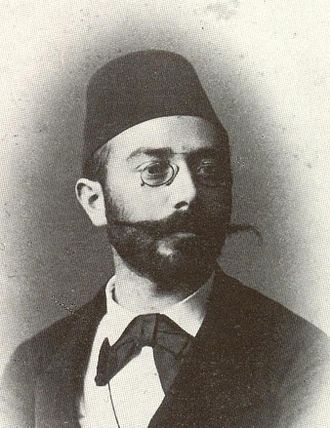
The chance find of this above-mentioned fragment of an ‘inscription’ among the ruins of Great Zimbabwe in the summer of 1891 provided Theodore Bent with an opportunity to make contact with one of the leading, if not the leading, Orientalists of his day – Eduard Glaser (1855-1908).
Correspondence between Bent and Glaser is in the process of digitisation by the Austrian Academy of Sciences Library, Archive and Collections: Information & Service (Vienna) as part of their fascinatingly important project Glaser Virtual World – All About Eduard Glaser. We are very happy to acknowledge the current owners of the material reproduced: Regionální muzeum K.A. Polánka v Žatci (K.A. Polánek Regional Museum, Žatec, Czech Republic) and Státní okresní archiv Louny (SOkA Louny) (State District Archives, Louny, Czech Republic).
To date (December 2023), five letters from Bent to Glaser have been scanned: they are associated with the former’s travels in present-day Zimbabwe (1891), Ethiopia (1893), and Southern Arabia (1894-97).
Letter 4 (19 July 1892) is of unique interest. In it Bent lists his reasons for his theory that the Great Zimbabwe ruins are of ‘Phoenician’ origin. His opinions are not presented in this exact way in any other known source.
The transcriptions that follow are provided by the editors (and include interpretations). Bent’s phraseology reflects his era. Selected comments are added below each letter (and are likely to be expanded in the future).
Letter 1: 1 February 1892 (GlaViWo – Archive: AT-OeAW-BA-3-27-LOAR-232-15-001)
[From 13 Great Cumberland Place, London, W.]
Dear Sir
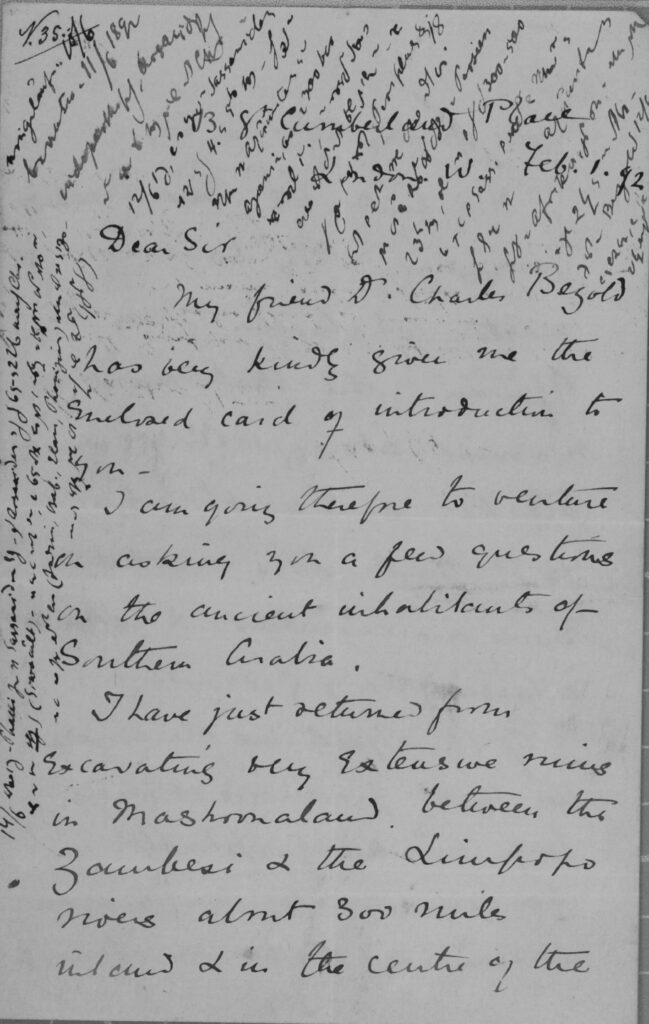
My friend [Dr] Charles Bezold has very kindly given me the enclosed card of introduction to you. I am going therefore to venture on asking you a few questions on the ancient inhabitants of Southern Arabia.
I have just returned from excavating very extensive ruins in Mashoonaland between the Zambesi and the Limpopo rivers about 300 miles inland and in the centre of the gold producing country.
My finds there are decidedly puzzling, they have no relation whatsoever to anything African; the buildings are massive stone walls of small granite blocks, 30 to 40 ft high and 15 ft thick – no mortar. Some are circular and cover a large area of ground.

Of the objects we discovered, the most prominent are a large number of phalli in soapstone; most of them are circumcised and are an almost exact reproduction of the organ. Many birds on pedestals, 5 to 6 ft high, also in soapstone, bowls of the same material with cleverly designed hunting scenes, etc., carved thereon – very good glazed pottery worked on a wheel.
The chief point in the largest circular building is a tower 32 ft high built of small granite blocks and entirely solid, also with a pattern a few courses below the summit.
In looking for a solution to this mystery we naturally turn to Arabia. That it was the capital of a gold producing population is obvious from the furnaces, crucibles, ingot moulds, etc., with traces of gold in them which we found there.
That the ruins are of great age is proved by the records of the early Portuguese travellers, who speak of them in exactly the same condition as now centuries ago, and the nature of our finds point distinctly to archaic art and archaic cult.
If you can give me any points from your knowledge of ancient Arabian art which will throw light on this question I shall be greatly obliged. May I ask for an early reply as I have to give in a report of my work to the Societies which sent me out.
Yours truly
J. Theodore Bent
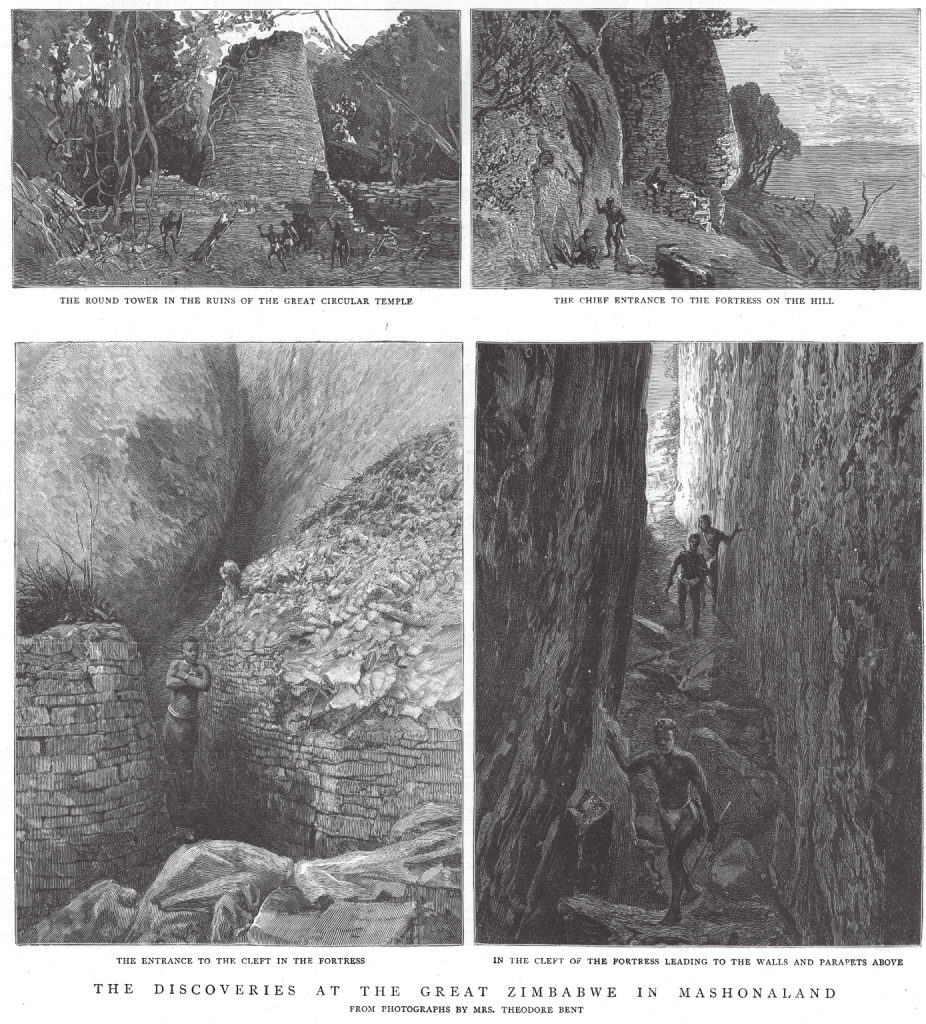
Notes: Bent reveals to Glaser some of his early discoveries and (erroneous) theories about Great Zimbabwe, as well as his developing interests in ancient links between certain African regions and ‘Southern Arabia’. Carl Bezold (1859-1922) was a German orientalist. Known primarily for his research in Akkadian (Babylonian-Assyrian), he also researched other Semitic languages: Syriac, Ge’ez (Ethiopic) and Arabic (source: Wikipedia). A colleague of Glaser’s at the University of Munich, Bezold probably became acquainted with Bent via the British Museum, but no other references to him in Bent’s works have surfaced to date. Interestingly, the letter is not on Bent’s usual headed notepaper. The couple only returned to London by ship at the very end of January 1892; it is possible that Bent drafted this letter at sea. The ‘Societies’ Bent refers to in his last sentence were the Royal Geographical Society and the British Association for the Advancement of Science. With typical enthusiasm and hard work, Bent was ready to present his results to the former by the third week of February 1892, and to the latter by the end of March (at which it is said that prime minister Gladstone himself was to attend).
Letter 2: 4 July 1892 (GlaViWo – Archive: AT-OeAW-BA-3-27-LOAR-232-15-003)
[On Bent’s letterhead, 13 Great Cumberland Place, London, W.]
Dear Sir
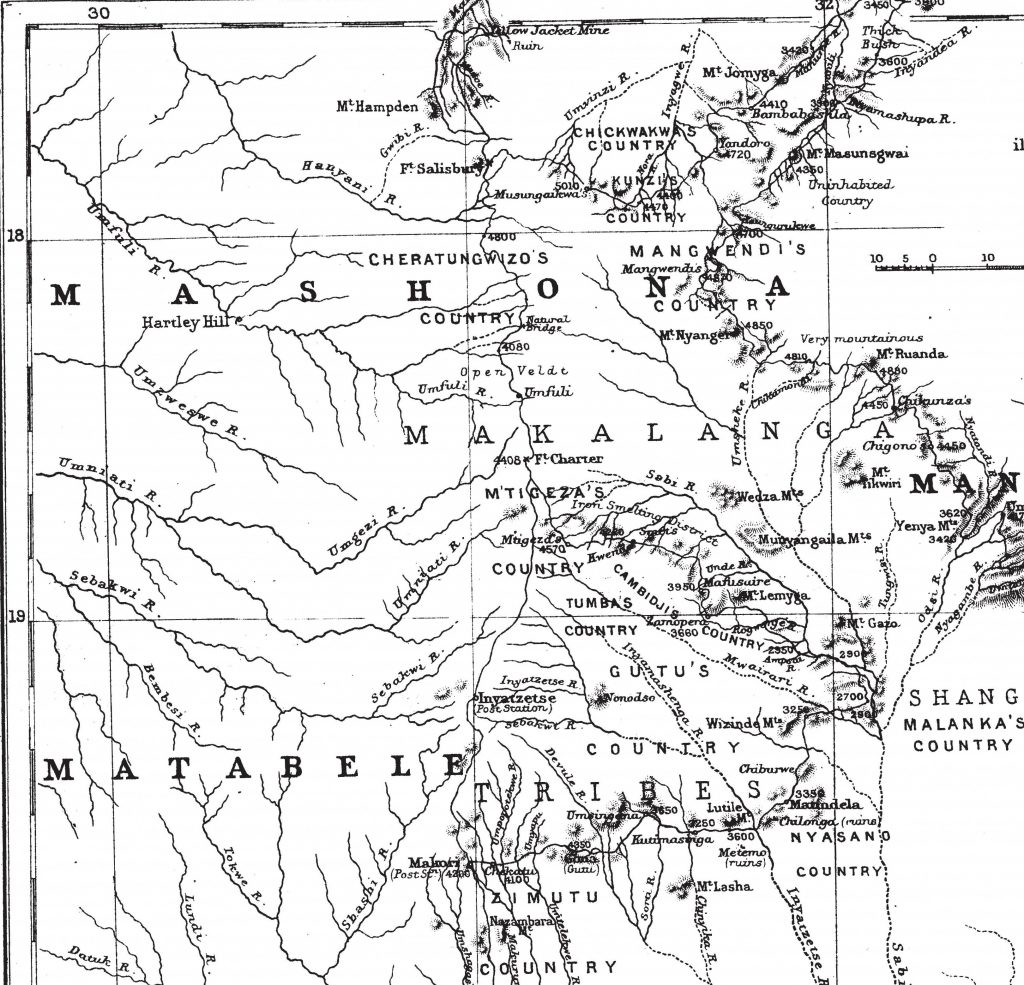
Thank you very much for your last interesting letter received on the 2nd [July 1892]. In answer to the questions you put me, I beg to state that the ruins we excavated are identical with those described most accurately by Herr Mauch, as far as he could do so without removing the mass of jungle and débris.
This spot Zimbabwe formed the capital of a long series of temple forts stretching up through the gold country from the Limpopo to the Zambesi, and to the west of the Sabi River. We visited six of the sites and they all correspond in structure and design – but we only excavated at Zimbabwe and there only found things in one particular spot, which is in the shade of a large rock, and hence had not been disturbed by the kaffirs, who build only in sunny spots.
All the bowls, ten in all, plain and decorated, of which we found fragments are of the same size, 21 inches in diameter, one represents a procession with offerings being carried, the rest of the patterns are from animal or vegetable life.
One fragment only would appear to have had an inscription round the lip, the few letters of which are so uncertain that I have not yet found anyone who can venture an explanation. I append a copy in hopes that you may be able to give some idea.
Yours sincerely
J. Theodore Bent
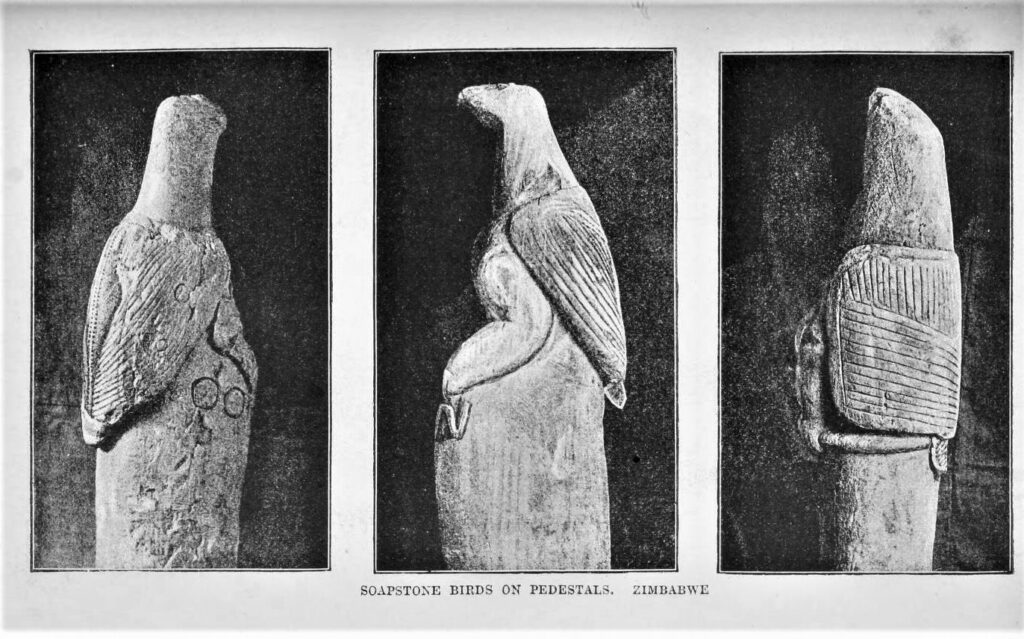
Notes: The hiatus between Bent’s letter of 1 February and this subsequent one is, as yet, unexplained; we await details of Glaser’s observations. Karl Gottlieb Mauch (1837-1875) was a German explorer and geographer of Africa. He reported on the archaeological ruins of Great Zimbabwe in 1871 during his search for the biblical land of Ophir (Wikipedia). For a panoramic (if not breathless) introduction to the region and the countless quests for its riches, see the section on ‘Mashonaland’ in J.M. Stuart, The ancient gold fields of Africa: from the Gold Coast to Mashonaland (London, 1891, p.201 ff; a reference to Bent’s theory p.231 [the link opens the personal copy of another great African adventurer, Hans Sauer]). Many of Bent’s finds, having been exhibited in the UK, were returned to the care of Cecil Rhodes, who gave some of them to the South African Museum, Cape Town (see, e.g., Edward Matenga, The Soapstone Birds Of Great Zimbabwe (2011). See Letter 3 (below) for more on the rim fragment.
Letter 3: 16 July 1892 (GlaViWo – Archive: AT-OeAW-BA-3-27-LOAR-232-15-004)
[On Bent’s letterhead, 13 Great Cumberland Place, London, W.]
Dear Dr. Glaser
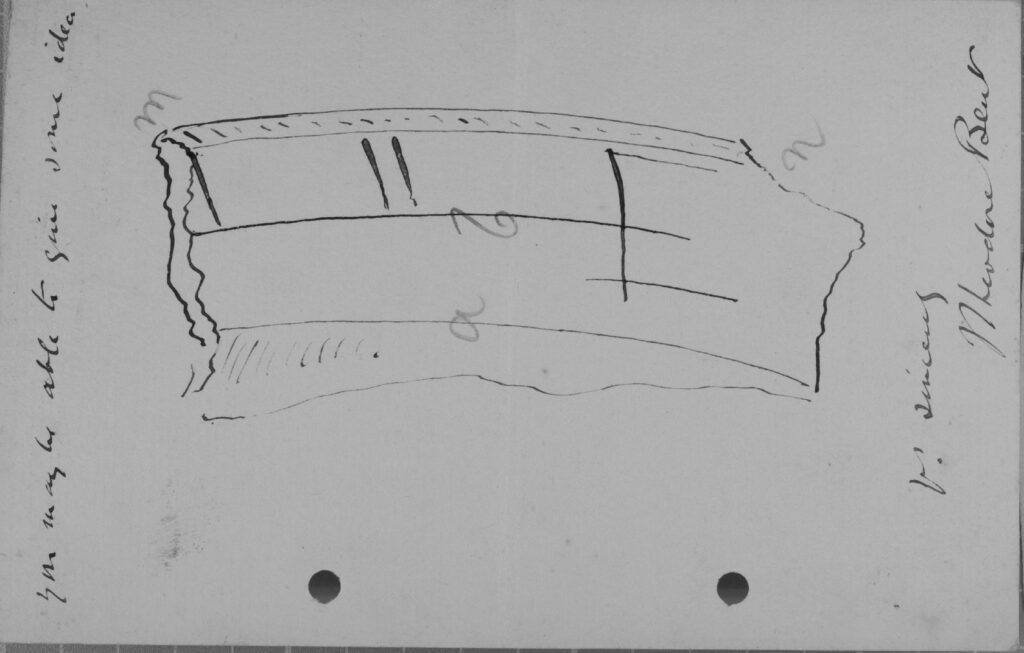
Many thanks for your letter of the 18th [?]. In reply to your questions, I beg to state that your sketch B (which I return to guide you) is exactly right. Line ‘a’ is the inner rim of the bowl where it slopes into the centre ‘m n’ is the outer rim; the inscription is on the flat surface between and consists only of this [drawing].
These lines are sharp and clear and evidently extended to the left where the fragment is broken, but not to the right. The fragment is 4 inches long and the flat surface 1½ inches wide. I may add that we have a large plain bowl without any lettering or figures of exactly the same shape which is 2 feet in diameter, and the fragments of the bowl all seem to have had the same radius and were 1 foot 2 inches in diameter.
Yours very truly
J. Theodore Bent
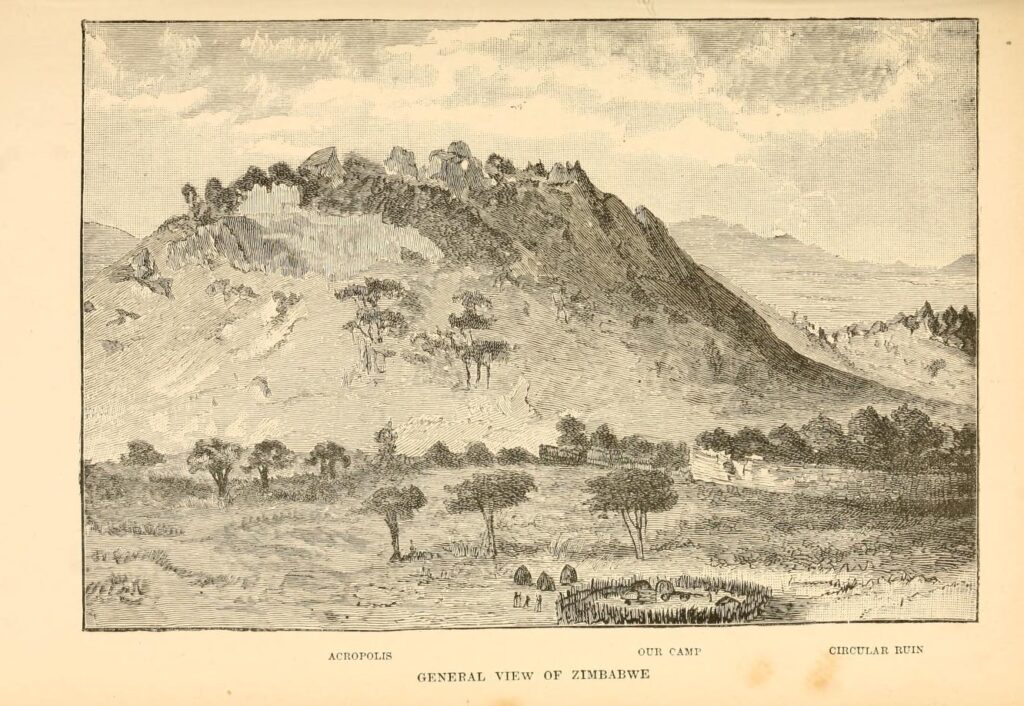
Notes: See Bent’s initial report (and illustration) of this sherd in his The Ruined Cities of Mashonaland (1892, p.198). Where this rim fragment is today is unclear; it was item 25 in a loan exhibition of antiquities from Zimbabwe held in the British Museum in London in 1930, the year after Mabel Bent’s death (‘Loan exhibition of antiquities from Zimbabwe and other ancient sites in Southern Rhodesia’, London: British Museum, 1930); some of Bent’s finds from Great Zimbabwe are identified in museum collections in Cape Town; hundreds of ethnographical items are in store in the British Museum, London. In a letter (from Lisbon?) to Scott Keltie at the RGS [13 January 1892, RGS Archives: ar/RGS/CB7/Bent, T&M] Bent writes “My inscription is Himyaritic and the nature of the ruins closely akin to Arabian, and I can prove the Sabæan origins of the ruins now beyond a shadow of a doubt…” The discovery of this sherd is problematic. In her diary, Mabel Bent writes (18 July 1891) of a “dream of an inscription, beginning ‘Iris’, unfulfilled as yet” by one of the excavators, Mr King. A later critic, Franklin White, in ‘Notes On The Great Zimbabwe Elliptical Ruin’, Journal of the Anthropological Institute of Great Britain and Ireland (1905, Vol.35, 39-47), writes that he has it from ‘a reliable authority’ that ‘some if not all of these lines are recent scratchings most probably made by some one in Mr. Bent’s escort’. One cannot help being reminded of the later controversy over the ‘Bethel Seal’ recovered from the Hadramaut, in which Glaser also plays a part.
Letter 4: 19 July 1892 (GlaViWo – Archive: AT-OeAW-BA-3-27-LOAR-232-15-002)
[On Bent’s letterhead, 13 Great Cumberland Place, London, W.]
My dear Sir
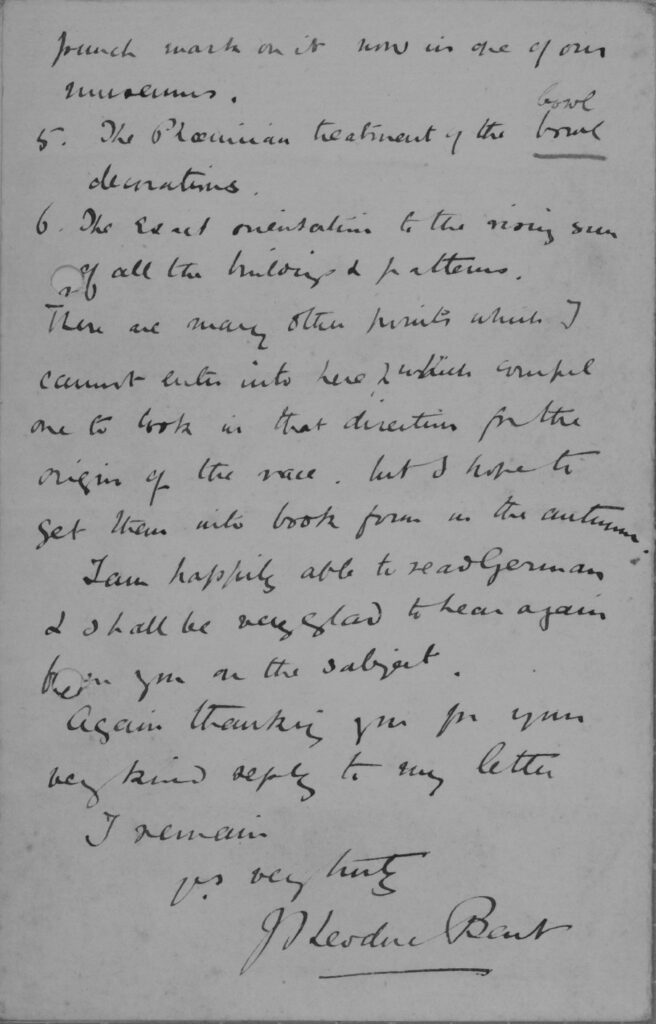
I am extremely obliged to you for the two letters you have written me and the interest you have shown in my South African discoveries.
Curiously enough, before I went out to Mashonaland I was firmly convinced that the ruins were of [Sasanian] origin, and so convinced was I on this subject that I made my theory public at a meeting of our Royal Geographical Society in 1890.
However after the inspection of the ruins and the results of our excavations I was reluctantly driven to abandon this idea, firstly because neither the ruins themselves nor the finds bore any resemblance to what we know of that race, and secondly because the time which elapsed between the possible date for that race to have occupied Mashonaland and the incursion of the present race of barbarians did not seem sufficient for so colossal an empire to have been built up and for such extensive gold workings to have been carried on. The whole country is honeycombed with deep shafts and the output of gold must have been enormous.
After a careful examination of all our finds I have been obliged to admit, though I must say with reluctance, a Semitic influence for the following reasons:
(1) The presence of a winged sun on the shaft of one of the phalli.
(2) The oft recurrence of the rosette in the decorations.
(3) A curious object with knobs left on it in relief is exactly the same as an object found in excavations at Paphos in Cyprus.
(4) An ingot mould for gold is exactly the same in pattern, namely ‘astragoloid’, as an ingot of tin with an Egyptian punch mark on it now in one of our museums.
(5) The Phœnician treatment of the bowl decorations.
(6) The exact orientation to the rising sun of all the buildings and patterns
There are many other points which I cannot enter into here and which compel one to look in that direction for the origin of the race, but I hope to get them into book form in the autumn.
I am happily able to read German and shall be very glad to hear again from you on the subject.
Again thanking you for your very kind reply to my letter.
I remain
Yours very truly
J. Theodore Bent
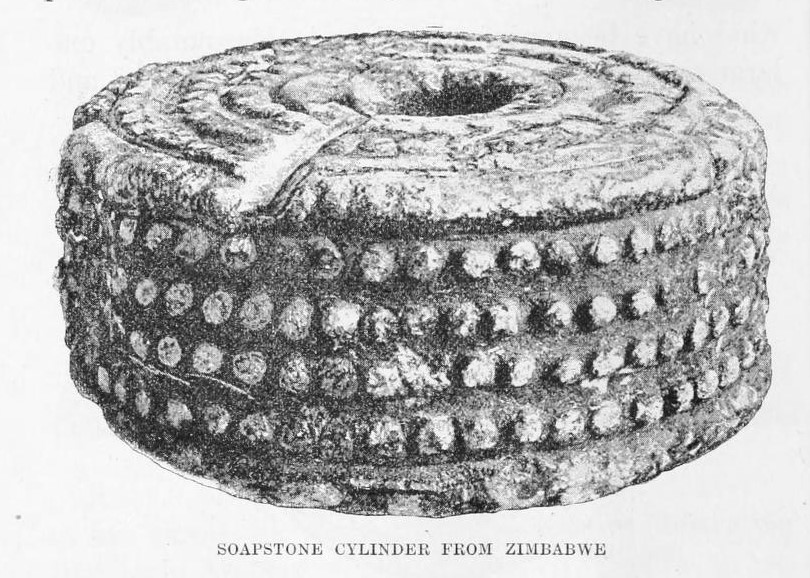
Notes: This letter is a revelation. For Bent’s earlier thoughts on the origins of Great Zimbabwe, see Proceedings of the Royal Geographical Society, n.s. v.13 (1891), pp. 1-21, following E.A. Maund’s eye-opening presentation to the RGS. Like a weather-vane, Bent was to alter his thinking many times and we may still feel he was ‘bounced’ by Rhodes, who had his own agenda. Ultimately, his published theory was disproved by archaeologists such as Caton-Thompson and others in the 20th century, clearly tarnishing Bent’s reputation. We are reminded of Grant Duff’s (apocryphal) anecdote: “Acton confirmed a story which I had heard, but not from himself, to the effect that Mr. Rhodes had asked him: “Why does not Mr. Theodore Bent say that the Zimbabwe ruins are Phoenician?” Acton replied: “Because he is not quite sure that they are.” “Ah!” said the other, “that is not the way that Empires are founded.” (Grant Duff, Notes from a Diary, 1896-1901, vol I, p. 185; London 1905). Bent indeed, with incredible speed, had his monograph on sale by the end of 1892; The Ruined Cities of Mashonaland proved a bestseller and ran to several editions.
Based on information received from Bent, Glaser drafted an essay in June 1892 on the discovery of Great Zimbabwe, the manuscript of which has survived: (Part 1) and (Part 2).
Letter 5: 27 April 1893 (GlaViWo – Archive: AT-OeAW-BA-3-27-ZAMU-11-02-133)
[Addressed from Bent’s home – 13 Great Cumberland Place, London, W.] [From a copy in another hand, made 30 April 1893]
Dear Sir
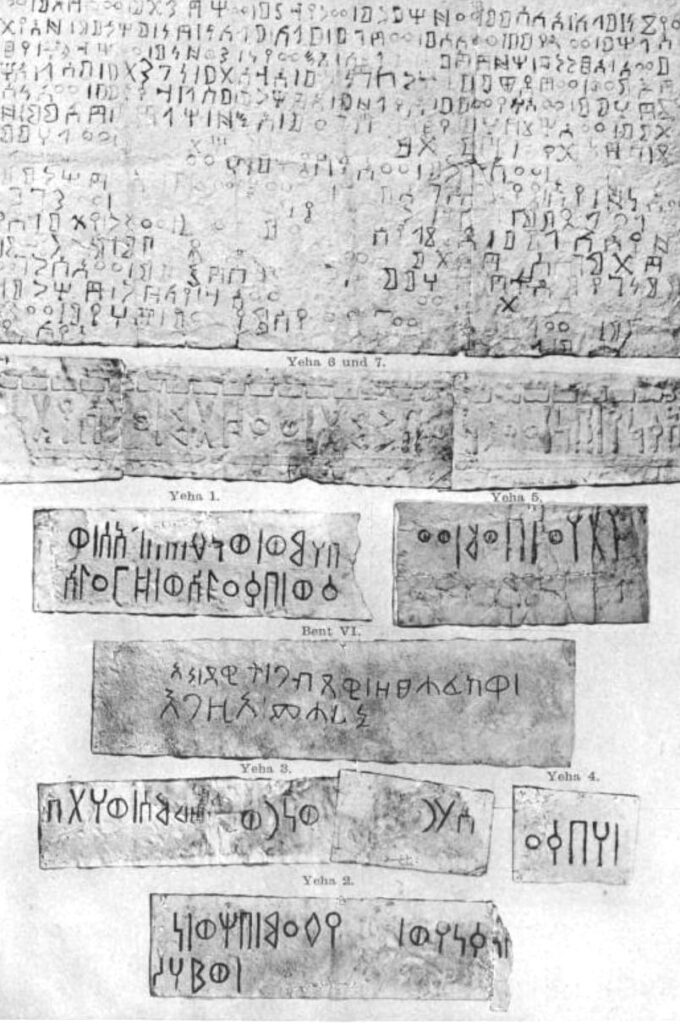
It is now some time since I corresponded with you about [our] finds in Mashonaland at Zimbabwe. Since then I have been in [Abyssinia] to Aksum. Near Adoua, I [illegible] Himyarite inscriptions and a temple, also at Aksum many very early [illegible] inscriptions closely akin to Himyarite. Being now thoroughly interested in this subject I am hoping next winter to go into Arabia and should [much] like to [know] what routes you have followed and what inscriptions you have [copied] so that I may take other [things] and not do your work over again.
If you will kindly give me information on this point I shall be greatly obliged. When the squeezes of my Himyaritic inscriptions arrive I shall have much pleasure [in] sending you copies; they are at present on the sea.
Yours very truly
J. Theodore Bent
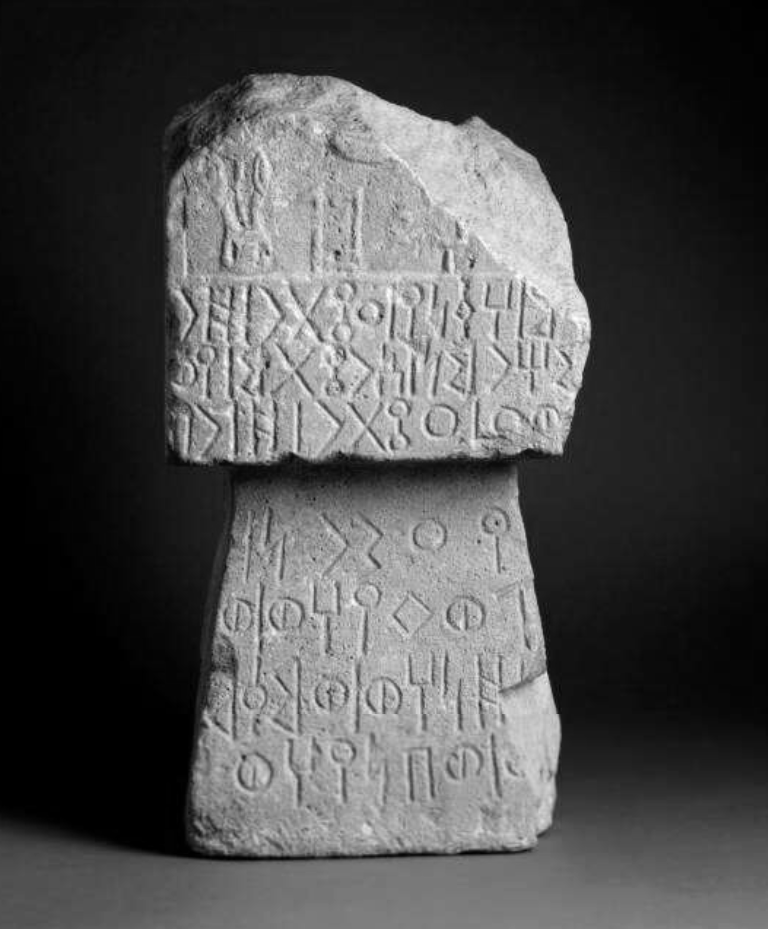
Notes: Glaser made four ground-breaking field-trips to ‘Southern Arabia’ (Yemen) between 1882 and the spring of 1894. The Bents were planning to make their first visit in the winter of 1893/4 and were keen not to duplicate Glaser’s work. It would have been fascinating were they all to have met up in Aden, the British port (with its eccentric hotels) all the travellers came to know well. Broadly speaking, the Bents were to interest themselves with the western extremes of the Wadi Hadramaut, while Glaser took to the east. Whether Bent ever sent Glaser the ‘squeezes’ to which he refers we are yet to learn (there is still a great deal of Glaser’s archive still to process), but the set he sent to D.H. Müller was published in 1894 (see the illustration above). These few lines by Bent are fateful, if not fatal. It is his pursuit of a dream to link up the early cultures and civilisations of certain African regions and ‘Southern Arabia’ (and we cannot rule out some associations with the mythical Queen of Sheba and the gold of Ophir) that led to his death from malarial complications in 1897 at the age of 45. (In Glaser’s 1895 study Die Abessinier in Arabien und Afrika, auf Grund neuentdeckter Inschriften (Munich), there are several references to Bent’s Aksum inscriptions.)
Acknowledgements and further information
We are extremely grateful to Elisabeth Cerny, Ronald Ruzicka, and George Hatke in Vienna for their invaluable assistance and authorisation to share this material (Copyright CC-BY-4.0 non-commercial, Austrian Academy of Sciences, Library, Archive & Collections, Project IF2019/27 Glaser Virtual World – All About Glaser).
Click for further references to Theodore Bent in the Glaser archive.
Elisabeth Monamy has written several articles on Glaser that can be recommended, including the entertaining graphic biography Eduard Glaser – From Bohemia through Yemen to Austria.
(all websites last accessed January 2024)
 Leave a comment or contact us about this article
Leave a comment or contact us about this article